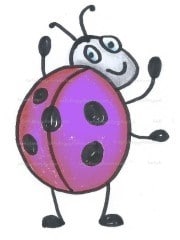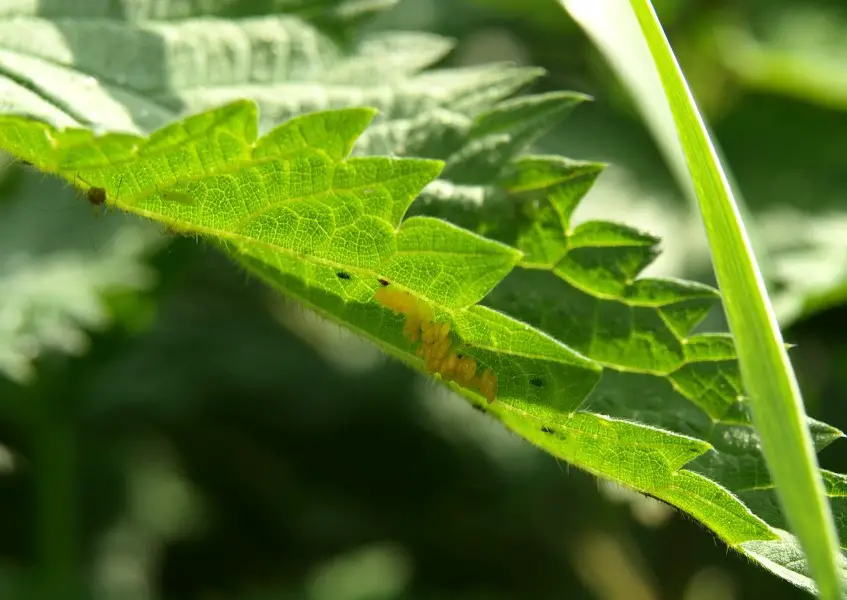When I first started liking Ladybugs – all those many years ago I quickly found out that there’s far more to Ladybugs than you might think.
In spite of this, there’s not much information about how amazing these bugs (sorry – beetles) actually are. So here I’ve compiled the largest list of interesting facts about Ladybugs, some of them are quite amazing and are things you perhaps never thought of before.
Now next time a Ladybird lands on you, you can proceed to amaze your friends and family with your extended knowledge. Some of these you may well know already, but I really hope you pick up one or two facts about Ladybugs here that you can use in the future.
I’ve also saved my favorite most wonderful fact till last. So here’s the list…
Here We Go – 66 Ladybugs Facts – Plus Some Bonus Facts
1. An adult ladybug may actually eat up to 75 aphids in a single day! A staggering general figure of 5000 Aphids during its lifetime.
2. In Victorian times, it was fairly common for doctors to mash up ladybugs for dental care! They would smear the resulting mixture in a patient’s mouth as a cure for toothache. There are no details as to whether this worked … quite frankly I doubt it!
3. In Switzerland, ladybugs are called “good God’s little fairy.” You can find out all the Ladybug names around the world here
4. Ladybugs can fly up to 37 mph – that’s as fast as a Race Horse
5. You can fit 80,000 ladybugs into a one-gallon jug. Quite why it has to be a gallon jug I’m not sure, but that’s still a lot of ladybugs!

Ever had a dream about Ladybugs?
Want to know what it means?
6. There are known to be 5000 species of Ladybugs in the world. 500 of those varieties are native or have been introduced into the US.
7. Male ladybugs are commonly slightly smaller than female ladybugs
8. The Ladybug is used as the official insect for the US states of Delaware, New Hampshire, Massachusetts, Tennessee, and Ohio
9. Officially speaking, Ladybugs are actually Lady Beetles, not actually bugs at all. The definition differences are that bugs have needle-like mouth parts, whereas, all species of beetles are classed as having chewing mouth parts as bugs mostly have a liquid diet. In addition, where beetles have hard wings, they are harder wings than bugs.
10. When a Ladybug is in flight, it beats its wings 85 times per second.
11. A ladybug’s spots are used to warn potential predators that this prey will not taste good.
12. A ladybug has two functioning eyes. They are not the white spots you see, but usually next to those on the outer edge of its head. However, they can’t see very well. Ladybugs can only really see differences in light or dark textures – find out more about how a Ladybug sees the world here.
13. Their spots fade in once they are a few hours to a day old. As they age, their spots fade out. Take a look next time you see one.
14. Ladybugs come in all manner of colors, the common red ones are predominant, but they also come in Grey, Black, Yellow, Pink, Blue, Orange, and some say Purple or Green.
15. Giving a gift of a Ladybug in some form or another for a newborn baby or child, is believed to provide them with protection.

16. The number of spots a Ladybug has does not denote their age. Some have 2 spots and others have more, all the way up to 24 spots. Some have stripes. And some, like the Paramysia oblonguttatahave for example, have none at all.
17. The Elytra, which is the outer shell with spots on it, is made of a material called Chitin, The same material that fingernails are made of.

To Work out if a Ladybug’s Dead, Dying, or Hibernating – click here
18. Ladybugs can smell with their feet
19. A ‘lady bird deed’ (also known as a ladybird deed) is a special form of life estate contract that affords the owner continued control over the property until their death. After they die, the property is transferred to new owners.
20. As cold-blooded species, ladybugs mainly are diurnal, meaning they are active during the day. This enables them to gain as much available sunlight for mating and feeding.
21. Ladybugs mainly communicate with each other through pheromones, these act as chemical signals.
22. The Ladybug name came about in ancient times. It is said that farmers prayed for the virgin mary to save their aphid-infested crops. Along came the Ladybugs, so the ‘lady’ part of their name was taken from the name of the Virgin Mary.
23. Young ladybugs pause in growth during winter hibernation – find out where they go in winter.
24. Once hatched, Ladybug larvae (singular; Larva) eat about 350 to 400 aphids in the space of around 2 weeks. One was recorded as eating as many as 475.
25. Ladybugs can fly up to around 3600 feet.
26. To help with pest control, Ladybugs are often released around San Diego Zoo and the San Diego Zoo Safari Park grounds.
27. Ladybugs cannot fly when temperatures are below 55 °F (13°C).
28. Ladybugs become more active once the temperature reaches near 60°F (16°C).
29. You can purchase Ladybugs online for your garden to help combat garden pests.
30. When Ladybugs Hibernate in groups, this is known as ‘diapause’
31. During the winter months, thousands of millions of Ladybugs can be seen congregating in South Western USA looking for hibernation spots

32. Ladybugs taste and smell with their antennae
33. Ladybugs can be a blessing and a curse for Vineyards. They eat the aphid pests, but if too many Ladybugs are processed along with the grapes, then their toxins can sour the aroma and taste of the wine.
34. Not all Ladybugs are carnivores, some ladybug species are known to eat plants instead of pests. Most Ladybugs also eat pollen, nectar, and honeydew.
35. When a female lays eggs, she will lay extra unfertilized eggs which act as a tasty snack for their newly hatched Larvae.

Ever seen a Purple Ladybug?
Find out more about
Purple Ladybugs
36. A Ladybug has Five defense mechanisms. Including releasing a toxic odor called hemolymph. Click here to see the other ways.
37. A strange phenomenon has been recorded of large quantities of Ladybugs washing up on shorelines. The largest recorded occurrence of this to date happened in the early 1940s, an estimated 4.5 billion Ladybugs, mostly dead but some alive, were spread along 21 km of shoreline in the Libyan desert coast
38. Ladybugs do not breathe through their mouths, but through parts of their abdomen and thorax through openings called Spiracles.
39. Ladybugs are programmed to hibernate for 3-4 months during winter, but could potentially ‘diapause’ for up to 9 months – depending on their fat reserves, available water and if any food is around
40. The typical number of eggs laid by a female in a year can be anything between 3 and 300, depending on species and other climate and available food source factors.
41. Once Laid, the Ladybug eggs incubate for a period of around 5 to 8 days before hatching.
42. Most Ladybugs have a complete life cycle of one year. However, some subspecies can live for up to three years
43. Ladybugs were believed to be around on Earth before many other living things appeared. In fact, they were here before many types of bacteria, before snakes, and before dinosaurs. As well as before coral reefs existed.
44. Female Ladybugs can carry the male sperm inside them for up to 3 months before deciding to use it.

Can Ladybugs Swim? Or Do they drown?
find out here
45. The typical length of most ladybugs is between .08 to 0.4 inches (2-10mm), depending on species. Up to as large as 0.7 inches (18mm).
46. Despite their defenses, Ladybugs are still preyed on by a number of insects and birds
47. The more aggressive Asian Lady Beetle, also known as the Harlequin Ladybug is an invasive species released by the US government in the mid-1900s to help reduce the agricultural pest population. It has since led to the depletion of native species.
48. Ladybugs can fly up to 74 miles, (120 km) per day – although this is rare.
49. Ladybugs in space! Four ladybugs inside a jar also containing aphids were included on a space shuttle as part of a zero-gravity experiment to study movement. It was found that the Ladybugs were still able to capture and eat their prey without the need for gravity.
50. Ladybugs can fly for up to 2 hours potentially covering 74 miles in a single flight
51. Once hatched, the larvae shed their skin several times. Once they’ve reached a large enough size, they stop eating and attach themselves to a plant leaf or stem to transform into the next life-cycle stage called the pupa.
52. A ladybug’s entire development life cycle only takes three to seven weeks before culminating in a fully grown ladybird adult
53. It is thought that Ladybugs who travel to mountainous and other areas follow pre-laid pheromone trails by the previous generation. They will also re-lay those pheromones for the next generation.

Find out what
seeing a Ladybird means for your love life
54. If you are a newlywed, and a Ladybug lands on you. Count the number of spots and that’s the number of children you’re going to have… Don’t hold me to that though!
55. If you happen to kill a Ladybug, it’s said you’ll be invoking a period of bad luck, said to last for nine straight days.
56. Ladybugs do bite humans. Usually, as a defense mechanism when feeling threatened, or if they mistake the human skin for potential food.
57. Ladybugs are not poisonous to humans, you’d have to eat lots and lots, like pounds worth of Ladybugs for it to start to become an issue
58. The most familiar Ladybug in the UK is the seven-spot ladybird, despite the invasion of the Asian Lady Beetle (Harlequin Ladybug)
59. Ladybugs are one of the few insects that people have said they’re less likely to kill if one is bothering them.
60. There are organizations that are currently surveying the spread of the Asian Lady Beetle in the US and the UK and request that people report findings.
61. The best ladybugs you can get for your garden or farm are called
62. Ladybirds typically lay around 10-15 eggs at a time. Mostly in rows, or clusters on the underside of a leaf, often near food sources like aphid colonies.

63. Ladybugs can be cannibals. At times when food is scarce, Ladybugs still need to survive. If need be they will eat their own kind. In particular, it will eat the larvae of other Ladybugs.
64. Each leg of the ladybug is adorned with fine hair that is adhesive. These hairs, enable them to cling to surfaces and climb more easily. However, the base of each hair is hard and stiffer for support.
65. Like many species, the population of ladybugs in some areas has been depleted due to chemical and pesticide pollution, as well as habitat destruction. Ladybugs are important to Humans and the Ecosystem.
66. The reason some Ladybugs have evolved with black shells is that many birds have evolved to avoid prey with red or black coloring.
Bonus Fact
67. A bit like we refer to a ‘Gaggle of Geese’. A collection of Ladybugs also has a name. Instead of the commonly referred to ‘swarm’ of Ladybugs’. They’re known as a ‘Loveliness of Ladybugs’. An example of use might be, ‘I walked by your garden the other day and saw a Loveliness of Ladybugs!’

Ever Seen a Green Ladybug?
Find out more about Green Ladybugs
Conclusion
And on that
And what was your favorite fact?
Also, if you have any friends or family that like Ladybugs as much as I do, then head over to my resource page to find some engaging Ladybug activities. As well as the best and most stylish selection of Ladybug gifts, lucky charms, and other items I’ve found over the years.



